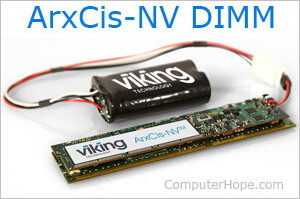NVRAM

Short for non-volatile random-access memory, NVRAM is a memory that saves its stored data regardless if the power is on or off. Today, a good example of NVRAM is flash memory like that used in a Jump drive. NVRAM is also in your computer monitor, printers, cars, smart cards, and other devices that require remembered settings.
Your computer RAM (random-access memory) is volatile, which means if you turn off your computer everything stored in the memory is lost. Although memory such as the ArxCis-NV from Viking is non-volatile RAM, it is only used with servers, not in a home computer.
Types of NVRAM
Today, there are different types of NVRAM available for all computers. The RTC/NVRAM on your computer motherboard is a battery-backed NVRAM that uses the CMOS battery to charge and store system settings such as the date and time.
Another good example of NVRAM in computers is the EEPROM (electrically erasable programmable read-only memory), which is used for the BIOS (basic input/output system) in many computers. Even your hard drive and other storage devices are considered non-volatile memory.
Ferroelectric RAM, FeRAM, or FRAM and Magneto resistive RAM or MRAM are also types of NVRAM used for various applications.
Why are the advantages and disadvantages of NVRAM?
Advantages
- NVRAM has no moving parts and is faster than volatile memory for both reading and writing.
- With less moving parts, NVRAM requires less power.
Disadvantages
- NVRAM that requires a battery that will eventually need to have the battery replaced.
- As information is re-written to flash memory, it deteriorates and will eventually no longer work.
CMOS, Computer acronyms, EPROM, Hard drive terms, Hardware terms, Memory terms, Non-volatile, PRAM, SRAM, Volatile
